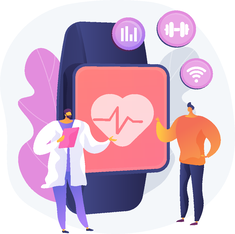With the worldwide outbreak of COVID-19, global leaders face the unenviable task of trying to save lives while avoiding economic collapse. Quarantines, along with stringent safety and security measures, have been put in place to slow the transmission of this fast-spreading disease.
Those infected with the coronavirus have reported a wide range of symptoms, from mild coughs to severe pneumonia. However, due to the asymptomatic nature of the virus, 25 to 50 percent of people with COVID-19 are unaware that they have the virus.
In fact, some patients only discovered that they had pneumonia and were suffering from oxygen deprivation after undergoing X-rays. This raises a serious question: how can we take preventive measures for a disease that we’re not sure if we have?
The answer might be surprisingly simple—by using already existing technologies. Leading medical research institutes, including Stanford, Harvard, UC San Francisco, and Scripps Research Translational Institute, have already started using consumer wearables with biosensors to collect data.

Their goal is to use the aggregated heart rate, blood oxygen, and respiratory rate to build an algorithm that would help detect and track Covid-19. Data collected from smart fitness trackers, smartwatches, smart bands and smart rings will be used as physiological signals to detect the body’s inflammation response. Even with the various symptoms of Covid-19 shown by asymptomatic carriers, the researchers hope the data may reveal early clues of coronavirus infection, even if we’re not showing any symptoms.
Not only can these devices help us maintain our mental well-being, but wearable edge devices, such as smart trackers and smartwatches, also offer a way to monitor our health continuously. Even though with social distancing in effect, a greater emphasis has been placed on hands-free devices to avoid physical contact with public screens, buttons, and controllers. By maintaining a baseline of our vital information, such as pulse and oxygen saturation, early detection of COVID-19 may be possible. And when you’re battling a disease where the symptoms may not appear until it’s too late, you want some indicator or suggestion that there may be something wrong. With edge devices such as these wearables, we are, in a way, enabled us to stay connected with ourselves, family, friends, caregivers, or even society at large.
Some countries and governments are already looking into using fitness bands to help track and detect COVID-19. In particular, researchers are collecting user data from fitness trackers to study the correlation between their respiratory rates and COVID-19 infections. It’s still early, but the data collected from these wearable trackers may play a significant role in helping us better understand the spread of this disease.
In order for the wearable technology to be the most effective, it must be powered on at all times. Until recently, this was a huge undertaking in terms of battery life. However, with Ambiq’s ultra-low-power SoC solutions, consumers now can get unmatched performance with long battery life. Whether you’re using a smartwatch, a smart band, or a smart tracker, Ambiq’s proprietary SPOT® platform enables them to last more than a week without charging. For more information on choosing the right System on Chip (SoC) for your wearable edge devices, please contact sales@ambiq.com. We hope to hear from you.


